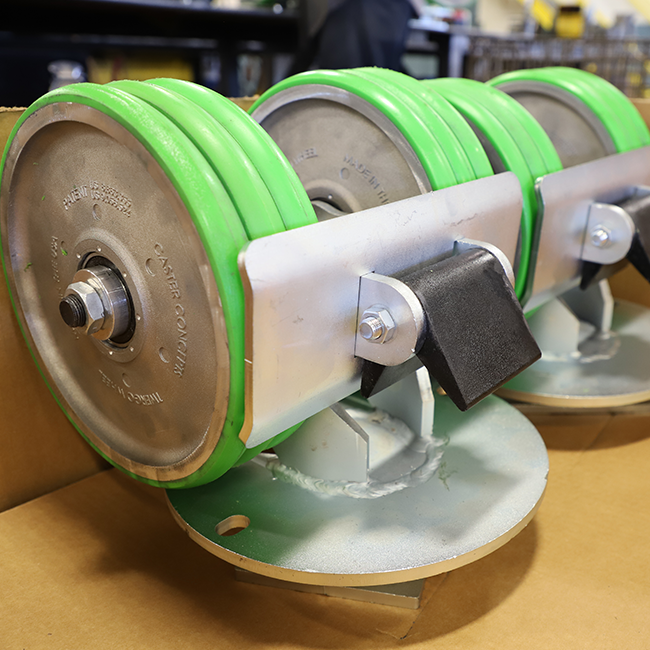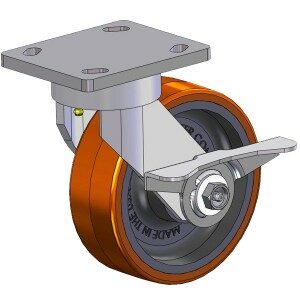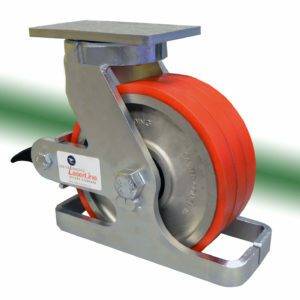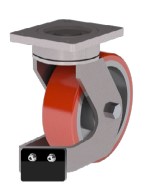

Caster Terminology Part III: Accessories


The 3rd and final part of this trilogy of casters terminology will cover caster Accessories. The most commonly ordered accessories are brakes and swivel locks. These can often be confused with one another, so much so that our sales rep, Tyler, has a video specific to the topic.
To distinguish between the brake and the swivel lock, let’s first define the purpose of each. All brakes are designed to stop the wheel from spinning within the caster, and in most cases, this means that the brake is going to be contacting the face of the wheel. A different style is our cam brake, which is mounted on the side of the wheel.
Cam Brakes and Swivel Locks

 Cam brakes typically work better in lighter-duty applications due to how they operate. To stop the wheel from spinning, you push the lever to engage the break, which causes a metal disc to be pressed into the leg of the caster. This squeezes the steel hub of the caster wheel to keep it from spinning.
Cam brakes typically work better in lighter-duty applications due to how they operate. To stop the wheel from spinning, you push the lever to engage the break, which causes a metal disc to be pressed into the leg of the caster. This squeezes the steel hub of the caster wheel to keep it from spinning.
A Swivel lock’s function is to keep a caster wheel from rotating from side to side. To do this, swivel locks use a pin that will sit in a notch cut into the swivel section on the yoke of the caster. When the swivel lock is locked, it will turn a swivel caster into a rigid caster that can only roll forwards and backwards. The main takeaway is that brakes will stop a caster wheel from spinning, while a swivel lock will keep a caster wheel from turning from side to side.
Another accessory to a caster can be a stem, and casters that have these are referred to as stem casters. These are commonly found on furniture such as office chairs, light-duty carts, or even in the medical field. Because Caster Concepts manufactures industrial heavy-duty casters, we do not produce any standard product stem casters because they are usually used in light-duty applications.
Toe Guards

 An accessory that can be rather self-explanatory is a toe guard. A toe guard keeps casters from rolling over and smashing a person’s toes or feet. They may also help guard other objects against being rolled over as well. Toe guards can either be built into the caster assembly as one solid piece during production or ordered as an additional attachment that we call a demountable toe guard that can be put on and taken off the caster at the user’s discretion. Whichever option is right for you, the guards are designed to rest just off the ground, so the wheel is still allowed to roll while the guard wraps entirely around it.
An accessory that can be rather self-explanatory is a toe guard. A toe guard keeps casters from rolling over and smashing a person’s toes or feet. They may also help guard other objects against being rolled over as well. Toe guards can either be built into the caster assembly as one solid piece during production or ordered as an additional attachment that we call a demountable toe guard that can be put on and taken off the caster at the user’s discretion. Whichever option is right for you, the guards are designed to rest just off the ground, so the wheel is still allowed to roll while the guard wraps entirely around it.
Toe guards are typically made from the same steel as the caster rig, but they can also be made of a softer material in cases where a customer would rather have the toe guard break than damage a piece of equipment or something it may run into by accident at a facility. Such materials could be polyurethane or plastic.
Some less common accessories are brush wipers, steering tubes, and reinforced legs.
Brush Wipers

 Brush wipers are added to give extra protection to the wheel against debris. Not all facilities are going to have clean floors. In shops that have metal shavings or other debris that can damage softer wheel material, like polyurethane, brush wipers can act like a plow and push debris away from the wheel and help avoid damage while adding to the longevity of the wheel.
Brush wipers are added to give extra protection to the wheel against debris. Not all facilities are going to have clean floors. In shops that have metal shavings or other debris that can damage softer wheel material, like polyurethane, brush wipers can act like a plow and push debris away from the wheel and help avoid damage while adding to the longevity of the wheel.
Steering Tubes
The addition of steering tubes helps maneuver heavy-loaded industrial caster in tight spaces. These tubes slide into a slot mounted onto the side of the caster rig, and the tubes themselves are not permanently attached.
Reinforced legs are another add-on that comes one of 2 ways: either made of angle iron on the outside of the caster leg or on the inside with gussets. This serves to strengthen the caster when exposed to side loading.
For a more in-depth take on any of these specific items, please view the learning center on our Caster Concepts website or any related videos or blogs.
Previous article
How to prevent caster wheel flat spotting on heavy weight applications.
Next article
What makes High Performance Polyurethane (HPPT) High Performance?